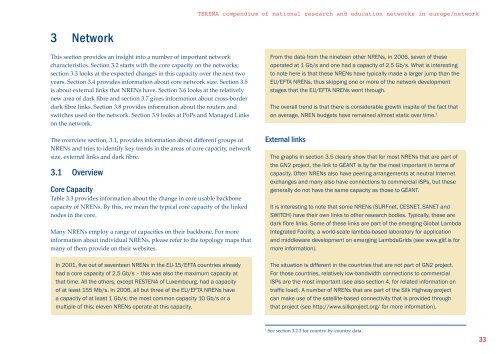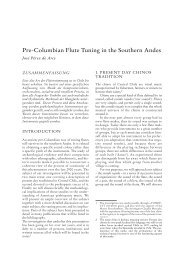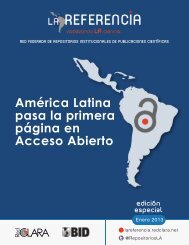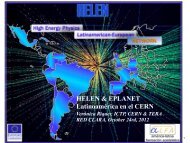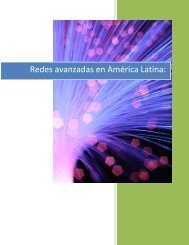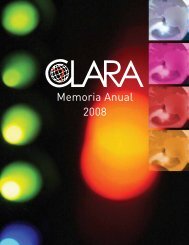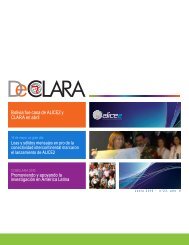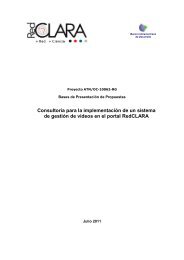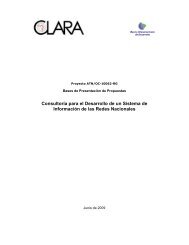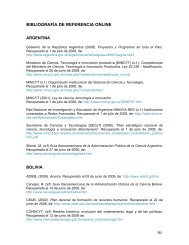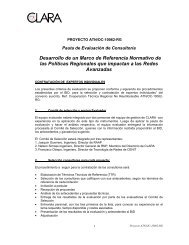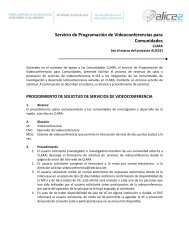full PDF version (2.1 MB) - Terena
full PDF version (2.1 MB) - Terena
full PDF version (2.1 MB) - Terena
- No tags were found...
You also want an ePaper? Increase the reach of your titles
YUMPU automatically turns print PDFs into web optimized ePapers that Google loves.
TERENA compendium of national research and education networks in europe/network3 NetworkThis section provides an insight into a number of important networkcharacteristics. Section 3.2 starts with the core capacity on the networks;section 3.3 looks at the expected changes in this capacity over the next twoyears. Section 3.4 provides information about core network size. Section 3.5is about external links that NRENs have. Section 3.6 looks at the relativelynew area of dark fibre and section 3.7 gives information about cross-borderdark fibre links. Section 3.8 provides information about the routers andswitches used on the network. Section 3.9 looks at PoPs and Managed Linkson the network.The overview section, 3.1, provides information about different groups ofNRENs and tries to identify key trends in the areas of core capacity, networksize, external links and dark fibre.3.1 OverviewCore CapacityTable 3.3 provides information about the change in core usable backbonecapacity of NRENs. By this, we mean the typical core capacity of the linkednodes in the core.Many NRENs employ a range of capacities on their backbone. For moreinformation about individual NRENs, please refer to the topology maps thatmany of them provide on their websites.In 2001, five out of seventeen NRENs in the EU-15/EFTA countries alreadyhad a core capacity of 2.5 Gb/s – this was also the maximum capacity atthat time. All the others, except RESTENA of Luxembourg, had a capacityof at least 155 Mb/s. In 2006, all but three of the EU/EFTA NRENs havea capacity of at least 1 Gb/s; the most common capacity 10 Gb/s or amultiple of this; eleven NRENs operate at this capacity.From the data from the nineteen other NRENs, in 2006, seven of theseoperated at 1 Gb/s and one had a capacity of 2.5 Gb/s. What is interestingto note here is that these NRENs have typically made a larger jump than theEU/EFTA NRENs, thus skipping one or more of the network developmentstages that the EU/EFTA NRENs went through.The overall trend is that there is considerable growth inspite of the fact thaton average, NREN budgets have remained almost static over time. 1External linksThe graphs in section 3.5 clearly show that for most NRENs that are part ofthe GN2 project, the link to GÉANT is by far the most important in terms ofcapacity. Often NRENs also have peering arrangements at neutral Internetexchanges and many also have connections to commercial ISPs, but thesegenerally do not have the same capacity as those to GÉANT.It is interesting to note that some NRENs (SURFnet, CESNET, SANET andSWITCH) have their own links to other research bodies. Typically, these aredark fibre links. Some of these links are part of the emerging Global LambdaIntegrated Facility, a world-scale lambda-based laboratory for applicationand middleware development on emerging LambdaGrids (see www.glif.is formore information).The situation is different in the countries that are not part of GN2 project.For those countries, relatively low-bandwidth connections to commercialISPs are the most important (see also section 4, for related information ontraffic load). A number of NRENs that are part of the Silk Highway projectcan make use of the satellite-based connectivity that is provided throughthat project (see http://www.silkproject.org/ for more information).1See section 3.2.3 for country-by-country data.33


